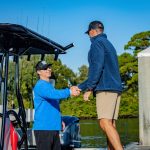For many anglers, the dream doesn’t stop at catching the big one; it’s about building a life around the water. Becoming a Cabo fishing charters combines passion, leadership, and business. It’s not just about reeling in fish; it’s about guiding others to unforgettable experiences on the sea.
If you’ve ever wondered how to turn your love for fishing into a full-time career, here’s a step-by-step guide to making that dream a reality.
What Does a Fishing Charter Captain Do?
A fishing charter captain is responsible for operating a commercial boat that takes paying customers on fishing trips. The job blends maritime skills with customer service and business management.
A typical day might include:
- Navigating offshore and inshore waters safely
- Helping guests learn to fish or improve their technique
- Maintaining fishing gear, bait, and tackle
- Managing bookings, payments, and marketing
- Ensuring compliance with marine and safety regulations
It’s a demanding role, but for the right person, few careers are as rewarding.
Step 1: Gain Experience on the Water
Before you can lead others, you need to know the sea.
Start by spending serious time on the water, not just for fun, but for skill-building.
Learn the Basics of Boating
- Understand navigation, tides, and weather patterns.
- Practice operating different types of boats.
- Get comfortable with docking, anchoring, and handling emergencies.
Build Your Fishing Knowledge
Study local species, seasonal patterns, and bait techniques. Many successful captains started as deckhands, learning directly from experienced professionals.
Tip: Volunteer or work on existing charters. You’ll gain real-world knowledge about customer service, logistics, and fishing hotspots.
Step 2: Meet Licensing Requirements
In most regions, especially in the U.S., you can’t just buy a boat and start taking customers out. You’ll need to earn an official captain’s license.
U.S. Coast Guard License
The most common credential is the OUPV (Operator of Uninspected Passenger Vessels) license, also known as the “six-pack” license. It allows you to carry up to six paying passengers.
Basic Requirements:
- At least 360 days of documented sea time, with 90 days in the last 3 years
- At least 18 years old
- Drug testing and background checks
- CPR and First Aid certification
- Physical exam and eyesight test
You’ll also need to pass a written exam covering:
- Navigation and plotting
- Rules of the road (COLREGS)
- Safety and emergency procedures
- Deck general and seamanship
Masters License
If you plan to operate larger vessels or carry more than six passengers, you’ll need a Master’s license, which has higher sea-time and vessel-size requirements.
Outside the U.S.
If you’re becoming a fishing charter captain in another country, check local maritime authorities for specific licensing rules. The process varies. Still, the fundamentals are similar: sea time, safety certification, and written exams.
Step 3: Invest in the Right Boat
Your boat is your livelihood; it’s also the first impression clients get when they step aboard.
Choosing the Right Vessel
- Size: 25–40 feet is common for day charters.
- Type: Centre consoles, sportfishing yachts, or catamarans, depending on your waters.
- Capacity: Match your license limit (six-pack or larger).
- Equipment: GPS, radar, radio, safety gear, and fishing electronics are must-haves.
You can start small; even a modest, reliable boat can earn a good income if maintained well and marketed smartly.
Maintenance and Safety
Regular inspections, clean decks, and functioning safety gear are non-negotiable. Many captains schedule daily or weekly checks to avoid downtime during busy seasons.
Step 4: Build Your Business Skills
A successful fishing charter captain isn’t just a skilled angler, they’re also a small business owner.
You’ll handle everything from pricing and scheduling to marketing and taxes.
Set Up Your Business Legally
- Register your business name.
- Obtain local business permits and insurance.
- Consider liability coverage for passengers and property.
Develop a Brand
Your reputation is your currency. Create a simple, memorable business name and logo. Then build your online presence.
- Website: Include pricing, photos, and reviews.
- Social media: Post catches, client testimonials, and trip updates.
- Local listings: Add your charter to Google Maps, TripAdvisor, and fishing directories.
Marketing Tips
- Offer special deals for first-time customers or groups.
- Encourage guests to post about their experience online.
- Partner with local hotels and travel agencies for referrals.
Pro Tip: High-quality photos of you and happy clients holding fish can do more for your bookings than any ad campaign.
Step 5: Focus on Customer Experience
Being a fishing charter captain means you’re not just selling fishing — you’re selling memories.
Teach, Don’t Just Drive
Not every guest knows how to cast or reel properly. Be patient and encouraging. For many, this might be their first time on the ocean.
Stay Professional
Weather changes, equipment breaks, or the fish don’t bite, but your attitude should stay calm and positive. Guests remember how you made them feel more than how many fish they caught.
Build Repeat Clients
Follow up after trips with thank-you messages or small discounts for their next booking. Word-of-mouth from happy customers is your most powerful marketing tool.
Step 6: Keep Learning and Growing
Even once you’re established, the sea is always changing, and so is the business.
- Upgrade Your License: Move from OUPV to a Master’s if demand grows.
- Maintain Certifications: Renew your CPR and drug tests regularly.
- Attend Industry Events: Fishing expos, tournaments, and seminars help you stay connected.
- Adapt to Trends: Offer eco-tours, night fishing, or family packages as your market evolves.
Many successful captains expand over time, adding more boats, hiring crews, or offering speciality trips like offshore trophy fishing or eco charters.
The Challenges (and Rewards)
Like any profession tied to nature, being a fishing charter captain comes with ups and downs.
Challenges
- Weather cancellations can disrupt income.
- Maintenance and fuel costs are high.
- Long hours and early mornings are the norm.
- Dealing with unpredictable guests requires patience.
Rewards
- Every day is different — new waters, new people, new fish.
- You get paid to be outdoors doing what you love.
- You become part of a close-knit community of seafarers.
- Watching someone catch their first big fish because of your guidance never gets old.
How Much Can a Fishing Charter Captain Earn?
Earnings depend on location, boat type, and season.
- Small operations: $40,000–$70,000 per year
- Established captains with multiple boats: $100,000+ annually
- High-end destinations (like Florida or Hawaii): Higher potential due to tourism demand
The best captains combine skill with savvy marketing and consistent client satisfaction.
Conclusion:
Becoming a fishing charter captain takes more than a love for fishing; it requires discipline, business sense, and a genuine desire to help others experience the thrill of the ocean.
It’s not a shortcut to wealth, but it’s a meaningful way to live a life connected to nature, community, and the sea. Every sunrise trip, every first catch, every laugh shared onboard becomes part of your story, a story written by salt, wind, and persistence.










